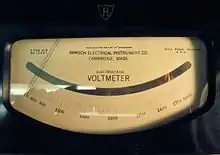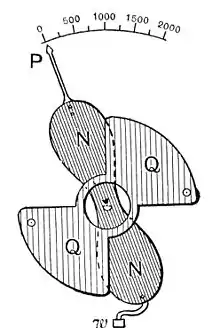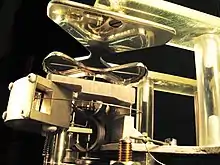Electrostatic voltmeter
Electrostatic voltmeter can refer to an electrostatic charge meter, known also as surface DC voltmeter, or to a voltmeter to measure large electrical potentials, traditionally called electrostatic voltmeter.

Charge meter
A surface DC voltmeter is an instrument that measures voltage with no electric charge transfer.
It can accurately measure surface potential (voltage) on materials without making physical contact and so there is no electrostatic charge transfer or loading of the voltage source.
Explanation
Many voltage measurements cannot be made using conventional contacting voltmeters because they require charge transfer to the voltmeter, thus causing loading and modification of the source voltage. For example, when measuring voltage distribution on a dielectric surface, any measurement technique that requires charge transfer, no matter how small, will modify or destroy the actual data.
Principle of operation
In practice, an electrostatic charge monitoring probe is placed close (1 mm to 5 mm) to the surface to be measured and the probe body is driven to the same potential as the measured unknown by an electronic circuit. This achieves a high accuracy measurement that is virtually insensitive to variations in probe-to-surface distances. The technique also prevents arc-over between the probe and measured surface when measuring high voltages.
Voltmeter


The operating principle of an electrostatic voltmeter is similar to that of an electrometer, it is, however, designed to measure high potential differences; typically from a few hundred to many thousands volts.
Principle of operation
An electrostatic voltmeter uses the attraction force between two charged surfaces to create a deflection of a pointer directly calibrated in volts. Since the attraction force is the same regardless of the polarity of the charged surfaces (as long as the charge is opposite), the electrostatic voltmeter can measure DC voltages of either polarity.
Typical construction is shown in the engraving. The pivoted sector NN is attracted to the fixed sector QQ. The moving sector is counterbalanced by the small weight w and indicates the voltage by the pointer P. In newer instruments the weight is replaced by a spring, thus allowing the meter to be used both in horizontal and vertical positions; this form is shown in the photograph. The fixed sector is insulated from the rest of the meter. The butterfly-shaped moving sector is made of a thin aluminum foil. Both the fixed and the moving sectors are highly polished and without any sharp corners to minimize high electrical stress areas. The movement of the sector is damped by an air vane, or by a conductive vane fixed between magnets. [1] In another variation, the pointer is replaced by a mirror, and the potential is indicated by deflection of a beam of light over a scale. [1]
The electrostatic voltmeter draws no significant current from the source when used on direct current, and a relatively small current due to the capacitance of the instrument when used with AC voltage. Instruments of this type were made with ranges of up to 100,000 volts full scale. [1]
References
- Manual of Electric Instruments, General Electric Meter and Instrument Department, 1949 pages 103-104
| Wikimedia Commons has media related to Electrostatic voltmeters. |